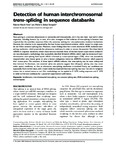Por favor, use este identificador para citar o enlazar este ítem:
http://www.alice.cnptia.embrapa.br/alice/handle/doc/577947Registro completo de metadatos
| Campo DC | Valor | Lengua/Idioma |
|---|---|---|
| dc.contributor.author | HERAI, R. H. | pt_BR |
| dc.contributor.author | YAMAGISHI, M. E. B. | pt_BR |
| dc.date.accessioned | 2011-04-10T11:11:11Z | pt_BR |
| dc.date.available | 2011-04-10T11:11:11Z | pt_BR |
| dc.date.created | 2009-12-15 | pt_BR |
| dc.date.issued | 2010 | pt_BR |
| dc.identifier.citation | Briefings in Bioinformatics, London, v. 2, n. 2, p. 198-209, 2010. | pt_BR |
| dc.identifier.uri | http://www.alice.cnptia.embrapa.br/alice/handle/doc/577947 | pt_BR |
| dc.description | Trans-splicing is a common phenomenon in nematodes and kinetoplastids, and it has also been reported in other organisms, including humans. Up to now, all in silico strategies to find evidence of trans-splicing in humans have required that the candidate sequences follow the consensus splicing site rules (spliceosome-mediated mechanism). However, this criterion is not supported by the best human experimental evidence, which, except in a single case, do not follow canonical splicing sites. Moreover, recent findings describe a novel alternative tRNA mediated trans-splicing mechanism, which prescinds the spliceosome machinery. In order to answer the question, ?Are there hybrid mRNAs in sequence databanks, whose characteristics resemble those of the best human experimental evidence??, we have developed a methodology that successfully identified 16 hybrid mRNAs which might be instances of interchromosomal trans-splicing. Each hybrid mRNA is formed by a trans-spliced region (TSR), which was successfully mapped either onto known genes or onto a human endogenous retrovirus (HERV-K) transcript which supports their transcription. The existence of these hybrid mRNAs indicates that trans-splicing may be more widespread than believed. Furthermore, non-canonical splice site patterns suggest that infrequent splicing sites may occur under special conditions, or that an alternative trans-splicing mechanism is involved. Finally, our candidates are supposedly from normal tissue, and a recent study has reported that trans-splicing may occur not only in malignant tissues, but in normal tissues as well. Our methodology can be applied to 5'-UTR, coding sequences and 3'-UTR in order to find new candidates for a posteriori experimental confirmation. | pt_BR |
| dc.language.iso | eng | eng |
| dc.rights | openAccess | eng |
| dc.subject | Bioinformática | pt_BR |
| dc.subject | Inter-chromosomal trans-splicing | pt_BR |
| dc.subject | Non-canonical splicing sites | pt_BR |
| dc.subject | TRNA-mediatedtrans-splicing | pt_BR |
| dc.subject | Banco de dados | pt_BR |
| dc.title | Detection of human interchromosomal trans-splicing in sequence databanks. | pt_BR |
| dc.type | Artigo de periódico | pt_BR |
| dc.date.updated | 2016-10-13T11:11:11Z | pt_BR |
| dc.subject.nalthesaurus | Bioinformatics | pt_BR |
| riaa.ainfo.id | 577947 | pt_BR |
| riaa.ainfo.lastupdate | 2016-10-13 | pt_BR |
| dc.identifier.doi | 10.1093/bib/bbp041 | pt_BR |
| dc.contributor.institution | ROBERTO HIROCHI HERAI, CNPTIA; MICHEL EDUARDO BELEZA YAMAGISHI, CNPTIA. | pt_BR |
| Aparece en las colecciones: | Artigo em periódico indexado (CNPTIA)  | |
Ficheros en este ítem:
| Fichero | Descripción | Tamaño | Formato | |
|---|---|---|---|---|
| APBriefBioinform2010Herai198209.pdf | 1,21 MB | Adobe PDF |  Visualizar/Abrir |









